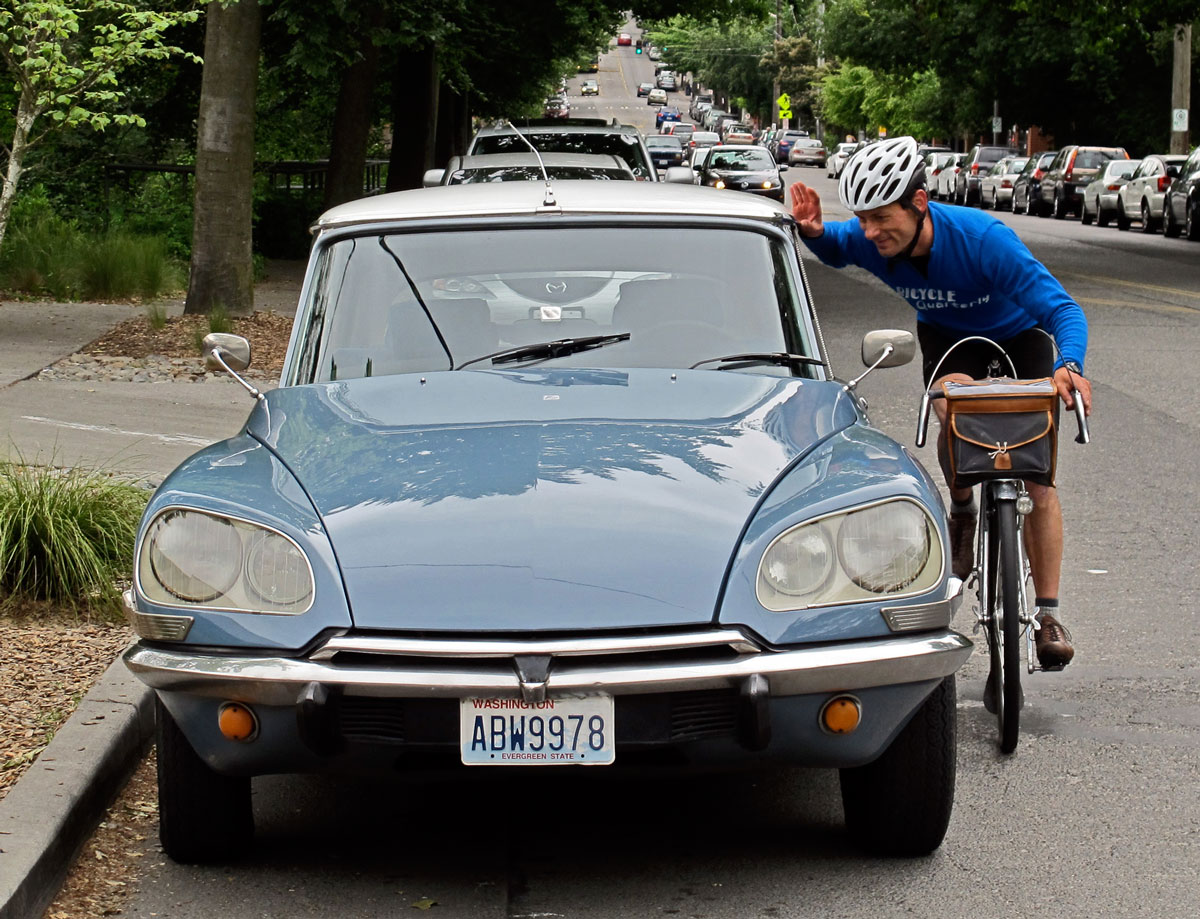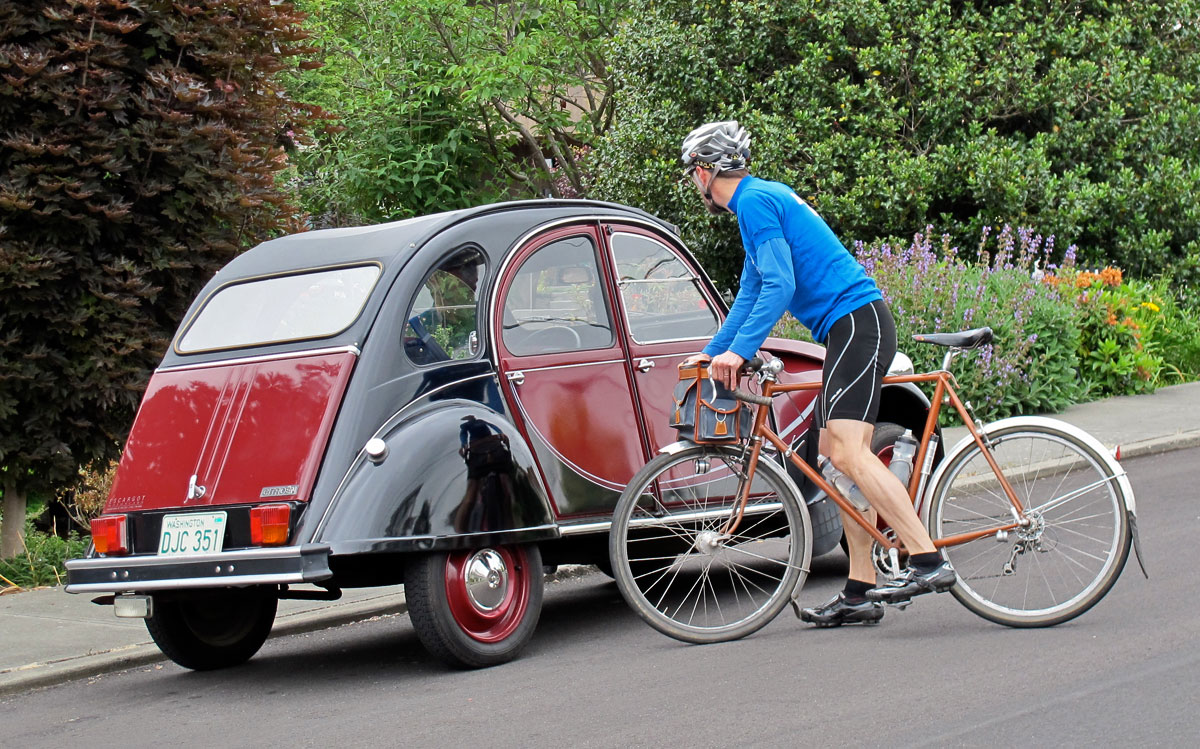Citroën Day

A recent ride with BQ contributor Mark was typical: a combination of great training, enjoying the sights, and stimulating conversation. Except that this one was enriched by encountering some of my favorite cars… (I am aware of the many problems cars have caused, and I rarely drive them, but I do enjoy them from an engineering and design perspective.)
After warming up on the Burke-Gilman Trail on our way out of Seattle, Mark and I raced each other up Juanita Hill. This long hill has just enough variation in pitch to make it truly challenging. By myself, I never ride it as fast as I do when Mark is either pulling ahead, or right on my tail. On this day, I thought I had made a winning break, until Mark reeled me in and passed me a few meters from the top. My legs were so exhausted that I hardly could keep the bike rolling on the plateau at the top. (I did a similar from-behind comeback on the climb out of Holmes Point, so we were even.) It’s fun and great training for the long-distance rides we have planned for the summer.

As we rolled into Kirkland, we noticed a rare Citroën DS convertible parked on a sidestreet. Somehow, the two-door body accentuates the futuristic profile of the DS even further.

I explained to Mark that Henri Chapron, the coachbuilder who made these Citroën convertibles, was located in Levallois-Perret, not far from René Herse’s shop. So my bike and this car are from the same place. Then I remembered that my new Herse was made in Colorado… and because original DS convertibles are incredibly rare, this “Décapotable” (convertible) may well have been converted from a standard Citroën DS in the U.S.

Just then, we spied a rare Citroën SM in the driveway. This luxury coupe used a Maserati engine and was probably the most advanced car of the 1970s. As a little boy, I always looked inside exotic cars to see how far the speedometer went. The SM’s goes to 160 mph…

One of the most amazing features of the European-spec SMs are the six headlights. The innermost ones turn when you steer the car. Only Citroën would dare to make a car like that – totally different from anything else on the market, and yet making a lot of sense. Looking inside, we admired the oval steering wheel. From the outside, we could see how the car tapered to the rear for better aerodynamics, which meant that the rear track is much narrower than the front. It’s even more unconventional underneath the avant-garde sheetmetal… You have to admire the audacity!

There was a third Citroën parked on the street, a 1980s 2CV. A much more prosaic machine, but no less audacious. Designed in the 1940s, this utilitarian car had a 602 cc flat-twin engine that revved to 7000 rpm. Who but Citroën would put a miniature race car engine in an economy car? And make the suspension interconnected, so the rear wheels react to bumps encountered by the front wheels, to smooth out the ride? There even was a four-wheel-drive version with two engines, one for each axle…

The 2CV was also one of the last (perhaps the last?) car to feature separate headlights. On this “Charleston” model, they are round and chrome-plated…

After this pleasant interlude, we stopped at a café. To continue the French theme, I ordered an almond croissant, and to my surprise, it was just as good as those I had eaten in Levallois-Perret, where the Citroën factory was located.
Looking at my bike, I realized I really have to re-wrap the handlebar tape… The wear pattern shows that I mostly use the “on the ramps” position that makes the Maes Parallel handlebars so comfortable.
We then continued our ride, with Mark excitedly describing his recent interest in Bayesian Statistics. In short, Bayesian statistical modeling involves specifying initial beliefs by defining a prior distribution and comparing it to each new piece of data, adjusting the distribution as you go along. This is radically different from the standard approach of testing a “null hypothesis”. It eliminates many opportunities for error and yields a more reliable result. It’s also more intuitive – it sort of replicates what we do when we make real-life decisions based on emerging data… (Mark and I rarely talk about bikes on our rides, since there are so many fascinating topics.)
On the way back into Seattle, we saw a fourth Citroën, this one a late-model DS in my favorite color (photo at the top of the post). It was a pretty good day out on our bikes!
Recommended reading: Wikipedia on the fascinating history of the Citroën 2CV.


